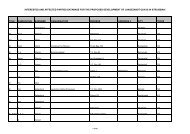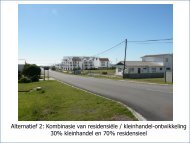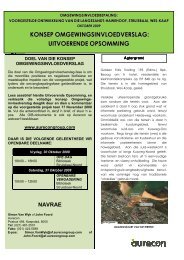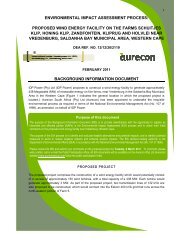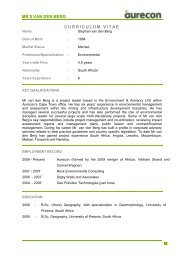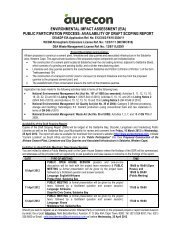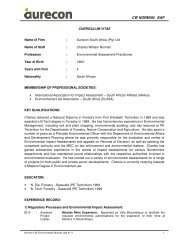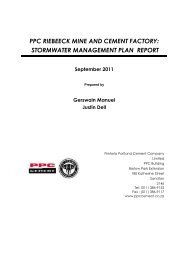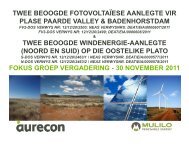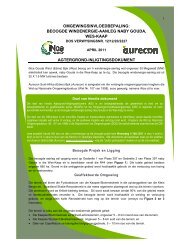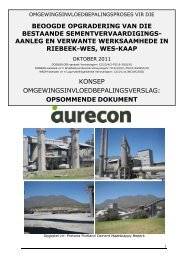Final EIAR - Aurecon AME Environmental | Environmental Projects
Final EIAR - Aurecon AME Environmental | Environmental Projects
Final EIAR - Aurecon AME Environmental | Environmental Projects
Create successful ePaper yourself
Turn your PDF publications into a flip-book with our unique Google optimized e-Paper software.
Proposed Wind and Solar (Photovoltaic) Energy Facilities on Kangnas Farm near Springbok in the Northern Cape: <strong>Final</strong> EIR 121<br />
Figure 4.37: Geological map of the region c. 50km east of Springbok, Northern Cape,<br />
showing the outcrop areas of the main rock units represented within the site, outlined in<br />
dark red (Map abstracted from 1: 250 000 geology sheet 2918 Pofadder, Council for<br />
Geoscience, Pretoria). The red triangle indicates the site of the Kangnasaurus<br />
Cretaceous dinosaur fossil site at the Goebees farmstead and the blue triangle the<br />
Miocene fossil horse locality at Areb (approximate position only). (Source: Natura Viva).<br />
Palaeontological heritage<br />
Sediments and fossils of probable Late Cretaceous age have been recorded in the Kangnas<br />
area of Bushmanland, representing some of the oldest remnants of post-Gondwana rocks and<br />
fossils from South Africa. The fossil material largely comprises the teeth and disarticulated postcranial<br />
skeletal elements (leg bones, vertebrae, ribs) of the ornithischian dinosaur<br />
Kangnasaurus. Associated fossils include calcified and silicified wood, lignite, leaf fragments<br />
and aquatic ostracods (microscopic seed shrimps). The dinosaur remains were first recorded<br />
from quartzofeldspathic grits, breccias and laminated calcareous mudrocks in a well and<br />
associated spoil heap at Goebees farmstead (Farm Kangnas 77) at a depth of some 34 m by<br />
Rogers (1915). The dinosaur material was subsequently revised by Cooper (1985), who<br />
considers the remains to belong to a single individual. Nevertheless, the taxonomic validity, age<br />
and systematic position of Kangnasaurus remain uncertain, with some workers regarding the<br />
genus as of dubious status. According to the most recent review, it was probably a basal<br />
bipedal, herbivorous iguanodontian related to Dryosaurus (Figure 4.38). There is a significant<br />
possibility that other small patches of fossiliferous crater lake sediments lie buried beneath the<br />
superficial sediment cover (sands, calcrete etc) within the site.<br />
© <strong>Aurecon</strong> (2012) No unauthorised reproduction, copy<br />
or adaptation, in whole or in part, may be made.<br />
P:\<strong>Projects</strong>\108495 Kangnas WEF & PV EIA's\3 Project Delivery\4 Reports\FEIR\FEIR 210213 <strong>Final</strong>.doc


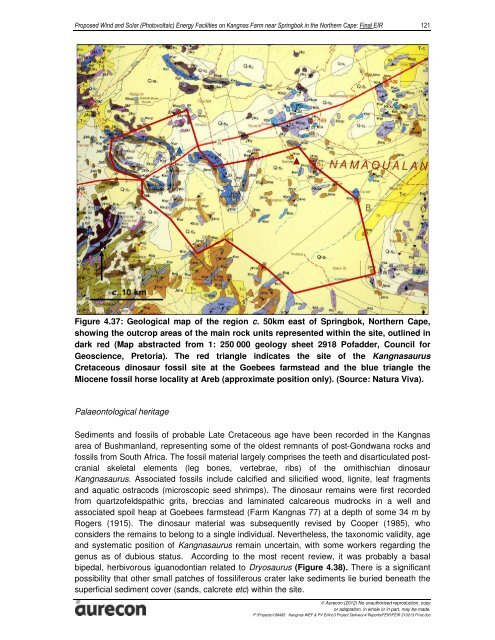
![CRR IV FEIR ~ 26042010 [FINAL].pdf - Environmental Projects](https://img.yumpu.com/21973020/1/184x260/crr-iv-feir-26042010-finalpdf-environmental-projects.jpg?quality=85)
